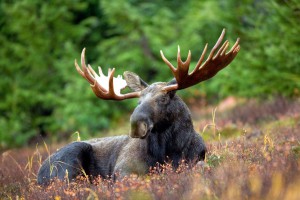 Elks are common across the entire region and most numerous in the north and south. In 18-20th centuries, the northwestern regions reported rises and declines of populations of elks. In early 1920’s, the elk was listed as protected in Russia. In the Pskov Region in 1945, elk hunt was forbidden, which resulted in the growth of the population. On average, the livestock of elks in 1983-87 comprised 24 thousand species, and in 1990 – 16.5 thousand. Elk hunting kill in 1978-1991 on average comprised 2 thousand species a year.
Elks are common across the entire region and most numerous in the north and south. In 18-20th centuries, the northwestern regions reported rises and declines of populations of elks. In early 1920’s, the elk was listed as protected in Russia. In the Pskov Region in 1945, elk hunt was forbidden, which resulted in the growth of the population. On average, the livestock of elks in 1983-87 comprised 24 thousand species, and in 1990 – 16.5 thousand. Elk hunting kill in 1978-1991 on average comprised 2 thousand species a year.
The good foraging and protective conditions – coniferous and deciduous renewals, and stricter protection measures – were conducive to the increase in the density of elk populations.
In forested areas, the elk sticks to pinewoods, provided there are logging sites, burn-outs, deciduous and coniferous undergrowth, as well as to shrubbery and forest edges. Elks feed on woody forage: branches, twigs and bark of deciduous trees (willow, aspen, mountain ash, birch, pine, alder etc.) In the summer, they forage at bog edges and swamped meadows, and along the banks of forest rivers and lakes. The regular feeding times are early morning and late evening.
The burgeoning populations of elk are of some concern among arborists, since they feed on shoots and tops of young pines, aspens and willows. At present, elk hunt is season-restricted and licensed mainly to the areas where elks are most numerous and harm forestry.
/ * The photos at lake.peipsi.org are cross-posted from commons.wikimedia.org and are used for familiarization purposes only. No commercial use of the photos is allowed. For more information about to use the photos see the originals on commons.wikimedia.org. /


